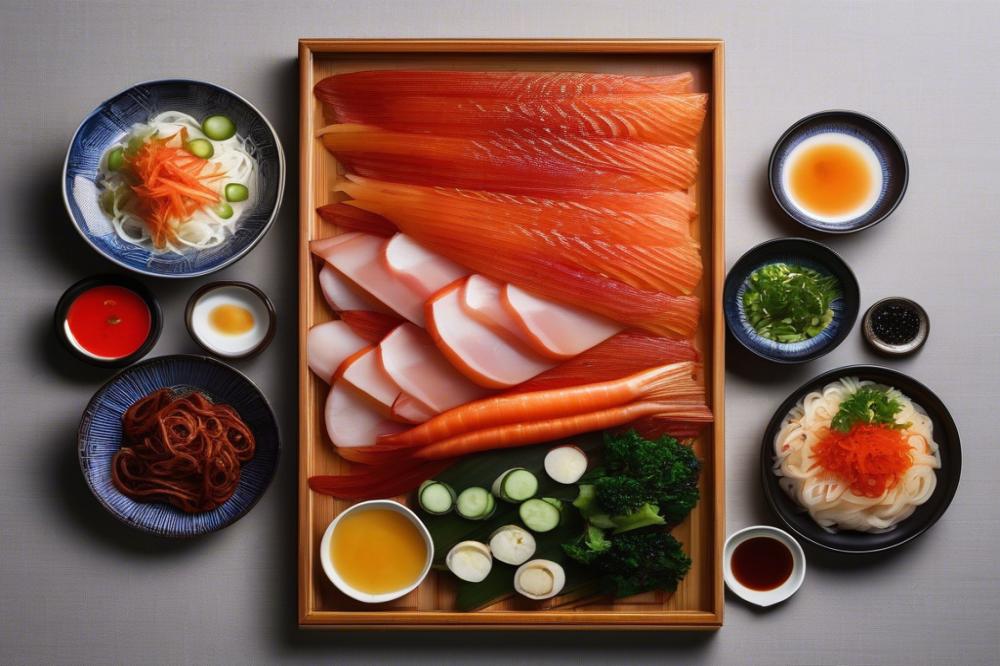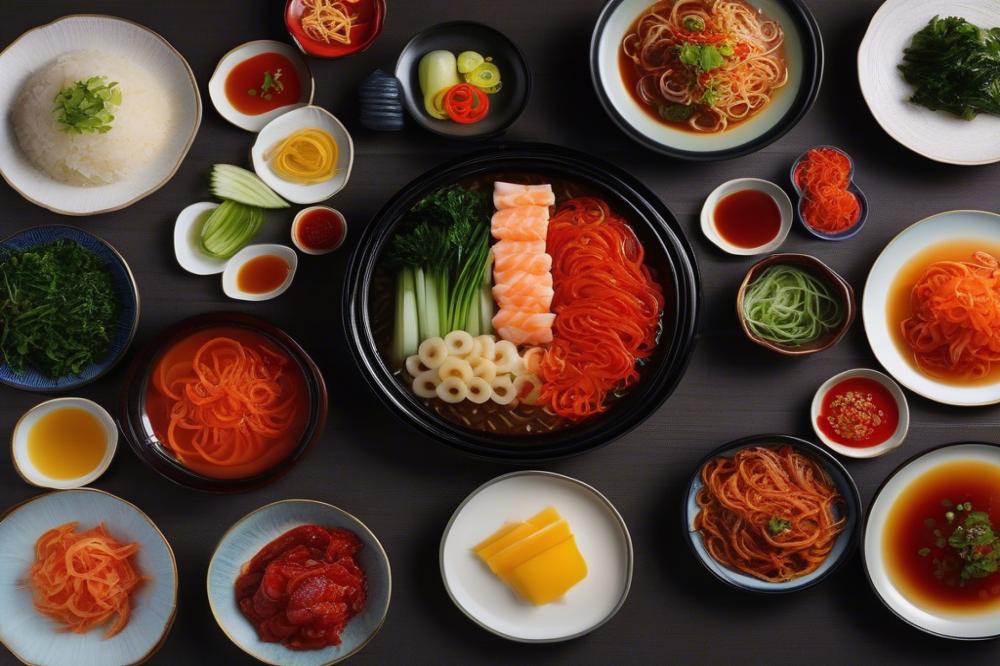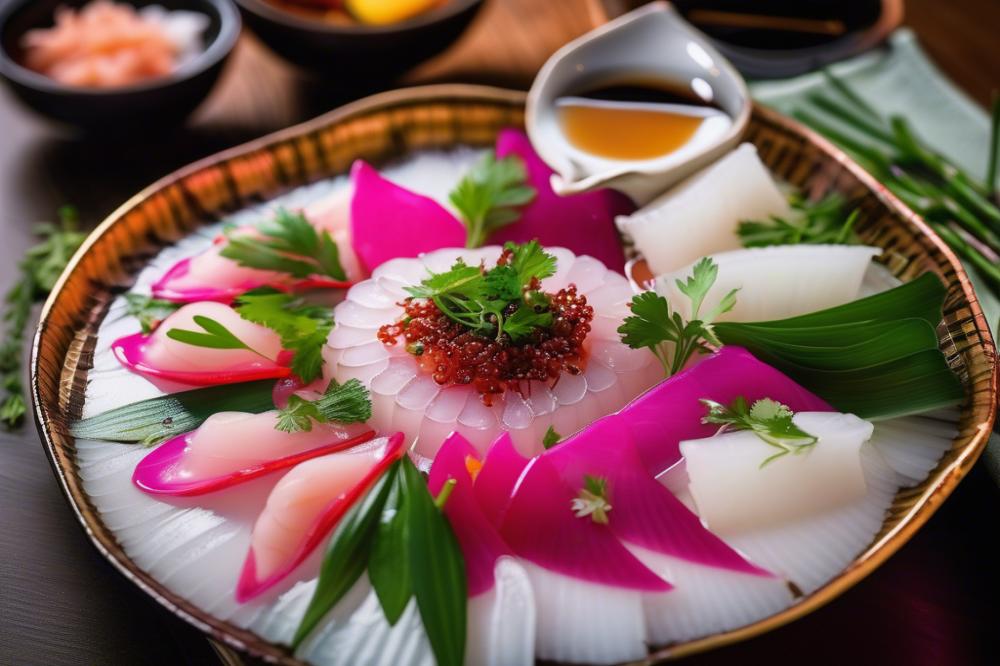Understanding Ojingeo Jeot: A Tangy Treasure of Korean cuisine
Ojingeo Jeot represents a fascinating facet of traditional Korean cuisine. This dish features fermented squid that showcases the rich culinary heritage of Korea. Fermentation has been a vital practice for centuries, allowing people to preserve seafood and enhance its flavors. fermented seafood, like Ojingeo Jeot, has its own distinctive charm that intrigues many food lovers.
Korean cuisine often highlights the importance of seafood preservation. Using techniques that date back generations, chefs create unique flavors by fermenting various ingredients. The fermentation process not only amplifies the natural taste of the squid, but it also introduces beneficial probiotics. This makes homemade jeot a popular choice among families who appreciate traditional recipes.
Umami flavor stands out when tasting Ojingeo Jeot. This savory depth provides a satisfying experience, making the dish an excellent complement to steamed rice and other Korean side dishes. In coastal regions, dishes featuring preserved seafood are especially beloved. They bring a taste of the sea to every meal, bridging the gap between the ocean and the dinner table.
When prepared thoughtfully, Korean Fermented Squid can evoke memories of home-cooked meals and tasty gatherings. Each bite tells a story, reflecting the care and tradition behind it. Exploring the world of this dish opens doors to understanding the broader context of Korean culinary practices. Enjoying Ojingeo Jeot is not just about the food; it’s about experiencing history on a plate.
Understanding Ojingeo Jeot

Definition of Ojingeo Jeot and Its Cultural Significance
Ojingeo Jeot is a popular type of fermented seafood found in Korean cuisine. This dish is made from squid, which is cleaned and then salted. As a staple in many households, it holds a special place in traditional recipes. Families often prepare it during gatherings, showcasing the importance of sharing food. Its deep umami flavor enhances many Korean side dishes. Many cherish the dish as a reminder of coastal communities where seafood is abundant.
The Role of Fermentation in Enhancing Flavors and Extending Shelf Life
Fermentation plays an essential role in making Ojingeo Jeot. This process not only improves the taste but also preserves the squid for long periods. When squid ferments, it develops complex flavors that are both savory and rich. The natural enzymes break down proteins, leading to that distinctive umami flavor that many people love. It also helps in keeping the seafood safe to eat, making it a practical choice for storage. After fermentation, the dish can last for months when kept properly.
Comparison to Other Korean Jeot Varieties
When compared to other jeot varieties, Ojingeo Jeot stands out due to its unique flavor profile. Other common types include jeotgal, which often uses fish, shrimp, or oysters. Each offers different tastes, influenced by the seafood used. For example, fermented shrimp has a stronger, saltier kick. The choice of seafood also affects the dishes in which they are served. Many enjoy mixing homemade jeot with rice or incorporating it into stews. Each type brings something distinct to the table, reflecting Korea’s culinary heritage.
Ingredients List and Preparation Method

Ingredients required for Ojingeo Jeot
To prepare this traditional Korean delicacy, you will need the following items. Quality squid is the main ingredient. Choose 2-3 fresh squid. Their skin should be shiny and clear, with no strong fishy smell. Next, take 1 cup of coarse sea salt. This salt is crucial for the fermentation process. You will also need 1 tablespoon of sugar. It increases the umami flavor and balances the saltiness. Consider using 2-3 cloves of garlic. Minced garlic adds a layered taste. Lastly, grab a small piece of ginger. About 1 inch, minced finely, will do wonders.
List of quantities needed for homemade preparation
For the main components, stick to the following measurements. Start with 500 grams of squid, which allows for good texture. Use 1 cup of coarse sea salt for proper preservation. Adding 1 tablespoon of sugar enhances the flavor profile. Garlic appears in a quantity of 2-3 cloves. Ginger is also measured at 1 inch. These elements create an excellent balance in the finished product.
Detailed cooking instructions for fermentation process
Start by cleaning the squid thoroughly. Remove the innards and the beak; rinse under cold water. Next, cut the squid into rings or tubes, depending on your preference. In a large bowl, layer the squid with salt. Make sure each piece is coated well. Sprinkle sugar over the squid uniformly. Mix gently to incorporate all ingredients. Cover the bowl with plastic wrap and let it sit at room temperature for 24 hours. This initial stage allows the squid to release moisture.
After a day, transfer the mixture into a clean jar. Pack it tightly, leaving little space at the top. Add minced garlic and ginger into the jar, ensuring an even distribution. Seal the jar tightly with a lid and place it in a cool, dark place. Let it ferment for at least one to two weeks. Periodically check for taste; the longer it ferments, the stronger the flavor becomes.
Tips for selecting fresh squid and other key ingredients
Choose squid caught earlier in the day when possible. Its freshness significantly affects the final product. Avoid any that show signs of discoloration or have a strong odor. When looking for sea salt, opt for unrefined varieties, as they contribute more nutrients. Fresh garlic and ginger should feel firm. Soft spots may mean they’re past their prime. Additionally, always use clean utensils to prevent unwanted bacteria from entering during the fermentation process.
Nutritional information for each ingredient, highlighting health benefits
Squid is an excellent source of protein, low in fat, and rich in vitamins B12 and A. These nutrients aid in energy production and support eye health. Sea salt contains minerals that are essential for hydration and maintaining electrolyte balance. Garlic is famous for its immune-boosting properties and can help lower blood pressure. Ginger is known for its anti-inflammatory effects, aiding digestion and reducing nausea. Each ingredient in this fermented seafood recipe brings valuable health benefits to the table. Homemade jeot can serve as a nutritious addition to various Korean side dishes, enriching meals while honoring traditional recipes.
The Fermentation Process

Creating that perfect fermented seafood dish can be rewarding. This process, especially when it comes to squid, requires careful attention. Each stage impacts the final flavor and texture of the dish. Start with fresh squid. Clean them thoroughly under cold water. Remove the head, innards, and skin. Cut the body into desired rings or strips.
Step-by-step explanation of the fermentation process
Next, prepare a mixture of coarse sea salt. This salt is crucial for fermentation. It helps draw out moisture from the squid. The squid should be layered in a container with this salt. Make sure every piece is well coated. Press down the squid gently to compact it.
Store the container in a cool, dark place. Allow it to sit for several days. The length of time may vary based on temperature. Warmer places may speed up the fermentation, while cooler areas slow it down. After about a week, check for any bubbly or cloudy liquid. This is a good sign that fermentation has started.
Factors affecting fermentation time and flavor development
Temperature plays a key role during this process. Warmer temperatures promote faster fermentation. However, they can also lead to spoilage if not monitored. The type of salt also matters. Coarse sea salt enhances the natural umami flavor. Choosing the right kind can improve your overall taste experience.
Additionally, the freshness of the squid impacts the flavor development. Fresher squid will often yield better results compared to older stock. Each batch can be slightly different, adding variety to your traditional recipes. The environment, like humidity, can also change outcomes. High humidity may slow down the dehydration process, extending fermentation time.
Common mistakes to avoid while fermenting squid
Avoid using iodized salt when fermenting. Iodine can interfere with the fermentation process. It may also alter the taste of your homemade jeot. Not packing the squid tightly can let air in. This might lead to unwanted bacteria growth, ruining the batch. Always check your container for leaks or signs of spoilage.
Ignoring the standing time can also lead to issues. If you do not let the squid ferment long enough, it may taste bland. Everyone loves rich flavors, especially in Korean side dishes. Lastly, be cautious about the amount of salt used. Too little can spoil the squid, while too much may create an overwhelming salty taste.
Serving Suggestions and Pairing

When serving Ojingeo Jeot, consider placing it on a small dish as part of a banchan spread. This arrangement highlights its role in Korean cuisine as a delightful side dish. The salty and umami flavor enhances the overall meal experience. Pairing it with steamed rice balances the flavors beautifully. This combination allows the rich taste of fermented seafood to shine through.
Kimchi serves as another excellent companion. Its spicy and tangy profile contrasts well with the savory notes of fermented squid. Dishes from coastal regions often include such seafood preservation methods. Adding a few pieces of pickled radish to the table can also elevate the flavors. The crunchiness of the radish complements the tenderness of the squid.
Ideas for Incorporating it into Different Recipes
Try using homemade jeot as a filling for kimbap. The squid will bring an exciting taste that surprises the palate. You can also mix it into a rice porridge for a comforting meal. The smooth texture enhances the dish while retaining its essence. Furthermore, consider stirring it into a simple noodle dish for added richness. This easy addition changes an ordinary recipe into something special.
Another idea involves using it in a spicy stir-fry. Combine it with vegetables and some gochugaru for intense flavor. Serving over rice will create a fulfilling entrèe. The fermentation process of the squid brings depth to any dish it touches. You can even create a dipping sauce by blending it with sesame oil and chopped green onions. This versatile approach opens doors to countless culinary possibilities.
If looking for a light salad, mix finely chopped squid with cucumbers and sesame seeds. This dish provides freshness while retaining the traditional savory elements. Adding a splash of vinegar can also enhance the flavors. Integrating Ojingeo Jeot into everyday meals adds a unique twist, keeping each bite interesting.
Exploring Coastal Dishes and Variants
Regional variations of fermented seafood showcase the diversity of Korean coastal cuisine. In different areas, chefs have their unique methods for preparing squid. Some locations prefer a sweeter sauce, while others lean towards saltier versions. These differences create a wide array of flavors and textures that delight anyone who tries them.
Across Korea, other seafood preservation methods are equally fascinating. Salted fish, known as jeotgal, often accompanies rice dishes. Sun-dried seafood, another common practice, offers a chewy and concentrated taste. Many households embrace these techniques, enhancing the shelf life of their catch while celebrating the essence of fresh marine ingredients.
The umami flavor in Ojingeo Jeot is just one example in a rich tapestry of traditional recipes. Families have passed down these methods through generations. Homemade jeot can hold a place of honor on any dining table. When served as part of the spread, these Korean side dishes add depth and character.
As part of a larger culinary tradition, this dish strikes a chord in Korea’s food culture. Fermentation process plays a pivotal role in many meals, connecting locals to their coastal heritage. Each bite offers a taste of the sea, blending history with everyday nourishment. The careful balance of flavors reminds everyone of the simple joys found in coastal dishes.
Final Thoughts on Ojingeo Jeot
Fermented seafood plays a vital role in Korean cuisine, and Ojingeo Jeot is no exception. This dish stands out for its rich flavors and unique preparation process. The experience of savoring the umami of fermented squid can transform an ordinary meal into something remarkable. Its salty and slightly sweet taste pairs well with rice and various side dishes. Enjoying this ingredient opens the door to a deeper understanding of Korean culinary traditions.
Making your own version allows for personal touches and adjustments in flavor. Why not embrace the challenge? Experimenting with the brining process can lead to delightful surprises. Fresh squid is often paired with simple yet effective ingredients. Creating a homemade version can be satisfying and fun. You might discover a new favorite or impress friends and family with your culinary skills.
Appreciating fermented foods goes beyond taste. These foods reflect history, culture, and the art of preservation. With Ojingeo Jeot, each bite offers a connection to generations of Korean heritage. Fermentation, in general, enriches the flavors, making them complex and exciting. As you explore homemade variations, remember that every batch tells its own story.
In closing, the journey of preparing Ojingeo Jeot offers more than just a dish. It introduces a lifestyle where flavors are deepened and traditions are honored. Embrace the process and let your palate discover the beauty of fermentation in Korean cuisine.



